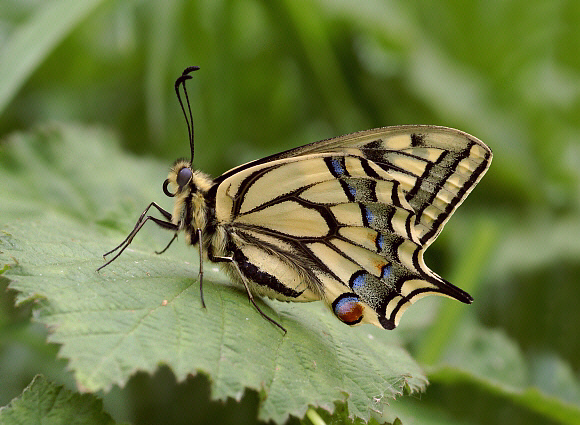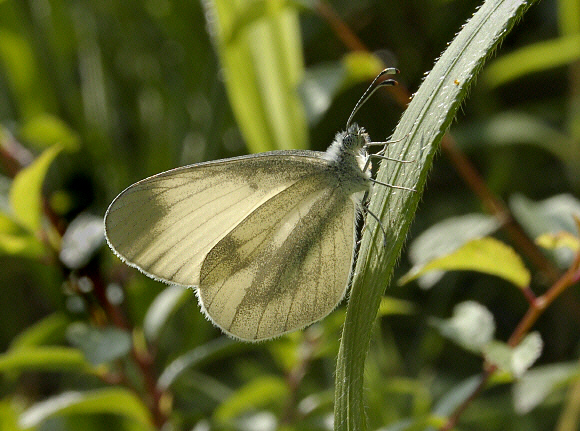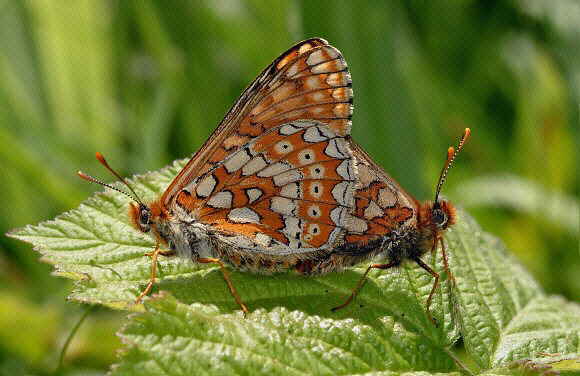 The middle section of the body, the thorax, is best thought of as a muscular anchor to which the head, legs, segmented abdomen, and wings are attached – Adrian Hoskins
The middle section of the body, the thorax, is best thought of as a muscular anchor to which the head, legs, segmented abdomen, and wings are attached – Adrian Hoskins
Thorax
The thorax consists of 3 body segments which are fused together, forming a chitinous cage which contains the flight muscles, and acts as an anchor point for the legs.
Within the thoracic cavity of flying insects are very powerful muscles which lever on the wings. The rapid expansion and contraction of the muscles causes the wings to rise and fall at rates of up to 1000 beats per second in bees and hoverflies, and about 200 beats per second in hawkmoths.
Amongst the butterflies, Skippers have the fastest wing beats. Their wings whirr audibly at a rate of about 20 beats per second as the butterflies dart rapidly from place to place. Other butterflies such as Swallowtails, Pierids and Satyrines can only manage about 5-10 beats per second. Slower still are the Ithomiines which have very deep beats at about 4 per second. Slowest of all are the Caligo Owl butterflies which struggle to achieve more than 2 or 3 beats per second.
Legs
All adult butterflies have 3 pairs of legs, except in the Nymphalidae and in males of certain other groups, where the front pair are reduced to brush-like stumps and modified as chemoreceptors.
The tibia of each leg has a subgenual ( under the knee ) organ, which detects and amplifies small vibrations. This alerts butterflies to ground vibrations caused by the approach of animals or birds, enabling them to respond instantly to danger. In most cases they take flight flight, but some species such as the Peacock Inachis io and Bullseye moths Automeris randa react by suddenly flashing open their wings to display “false eye” markings that startle the predator.
The tibia on the forelegs of Pieridae, Hesperiidae, Papilionidae and Lycaenidae are often equipped with a flexible spur through which the antennae can be drawn for cleaning.
The spur also functions as a spike with which a female can puncture the cuticle of a leaf, causing it to bleed minute quantities of chemicals. The butterfly then checks the chemical composition of the leaf, using olfactory sensors on her legs and feet. This enables her to determine whether the plant is of the correct species to support her offspring. Thus a female will spend long periods flitting from leaf to leaf, “tasting” each one with her feet to assess its suitability prior to egg laying.

Wood White Leptidea sinapis, Surrey, England – Adrian Hoskins
The Wood White Leptidea sinapis, like all Pieridae species, has 6 fully functional legs. Males of some Pieridae such as the Brimstone Gonepteryx rhamni often rest with the forelegs held tight against the body, so at first glance can appear to have only 4 legs.

Euphydryas aurinia, a Nymphalid with only 4 functional legs in both sexes – Adrian Hoskins
Abdomen
The abdomen contains the digestive system, breathing apparatus, a long tubular heart, and the sexual organs. The abdominal exoskeleton is multi-segmented. Each of the 10 segments is comprised of a ring of a hard material called chitin. The segments are linked by flexible tissues, allowing the abdomen to bend, a necessity for copulation and egg-laying.
Reproductive organs
The genitalia are at the tip of the abdomen. Each species has uniquely shaped genital armature – the male “key” only fitting the correct female “lock”. Because the armature is unique to each species, taxonomists have traditionally relied heavily on microscopic examination of genitalia to determine species and their relationship with other taxa. The advent of DNA analysis and advances in phylogenetics however now mean that genitalia study is just one of many techniques adopted.
Females are equipped with an ovipositor, used to release and deposit the fertilised eggs. In most species this is short and not normally visible, but in certain moths it is modified into a long “sting-like” tube so that the eggs can be inserted into chinks in the bark of trees.
Coremata
The males of many neotropical Arctiid moths, including Creatonotos transiens possess at the tips of their abdomens an extraordinary eversible organ called a coremata. An unmated female “call” to males by releasing pheromones from the tip of her abdomen. Males are attracted by the scent and arrive on the scene, forming a lek, often comprising of a dozen or more individuals.
Experiments have demonstrated that males which have accumulated plant-derived pyrrolizidine alkaloids ( PAs ) then respond by everting their coremata and releasing pheromones. The PAs are passed to females in a spermatophore during copulation, conferring them with toxic qualities that protect them from predation, and also increasing their longevity and fecundity.
Captive males that have been deprived of PAs do not evert their coremata or release pheromones. It seems likely therefore that the females are able to select which males to mate with on the basis of the strength of their pheromones – i.e. choosing the male with the highest PA delivering ability.
Spiracles
On the sides of each segment are microscopic holes called spiracles, through which air enters and leaves the body. Slight rhythmic movements of the body, coordinated with the opening and closing of the spiracles, causes air to be drawn into tiny lung-like sacs, and later expelled.
Digestive system
Butterflies feed exclusively on liquids which may according to species include nectar, dissolved pollen, mineralised water, liquefied dung, urine, sweat, bodily fluids from decomposing animal corpses, and in some cases even tears from the eyes of alligators ! After digestion and extraction of proteins and other minerals the waste matter is expelled from the anus either in liquid form, or as tiny faecal pellets.
Sound producing organs
Insects such as cicadas and grasshoppers are well known for producing courtship songs, but most people only associate other insects with “incidental” sounds such as the buzzing of wings. There is a great deal of evidence however that insects in general, including lepidoptera, produce sounds that fulfil a variety of functions. Many of these sounds are beyond the range of human hearing, and can only be detected with specialised acoustical equipment. In some butterflies however the sounds are clearly audible.
Hamadryas butterflies can produce a crackling sound by twanging 2 tiny prongs on the tip of their abdomens against bristles on the valvae. This is discussed further on the next page.
Nocturnal moths are commonly preyed upon by bats, which project a series of ultrasound clicks and listen to their echoes in order to locate flying moths. Many moths have developed “ears” on their wings or thorax which can alert them to approaching bats, enabling them to take evasive action. The neotropical tiger moth Bertholdia trigona goes a stage further – it actively jams the bats “radar” by producing its own ultrasound, by vibrating a tympanal organ located on its metathorax.
